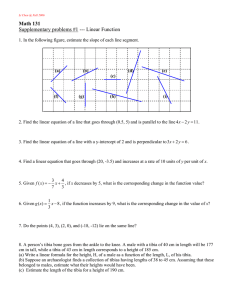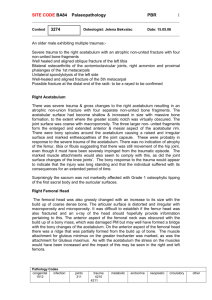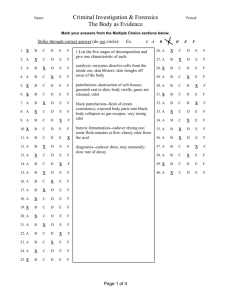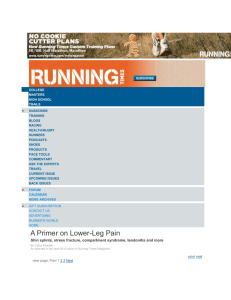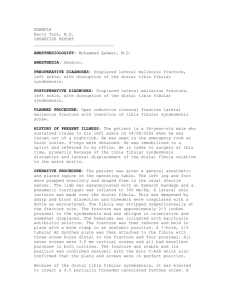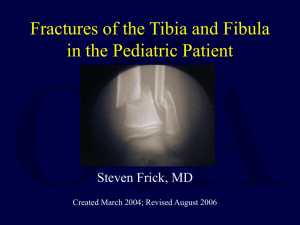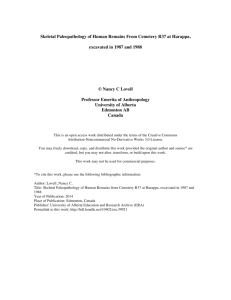3013 - Museum of London
advertisement
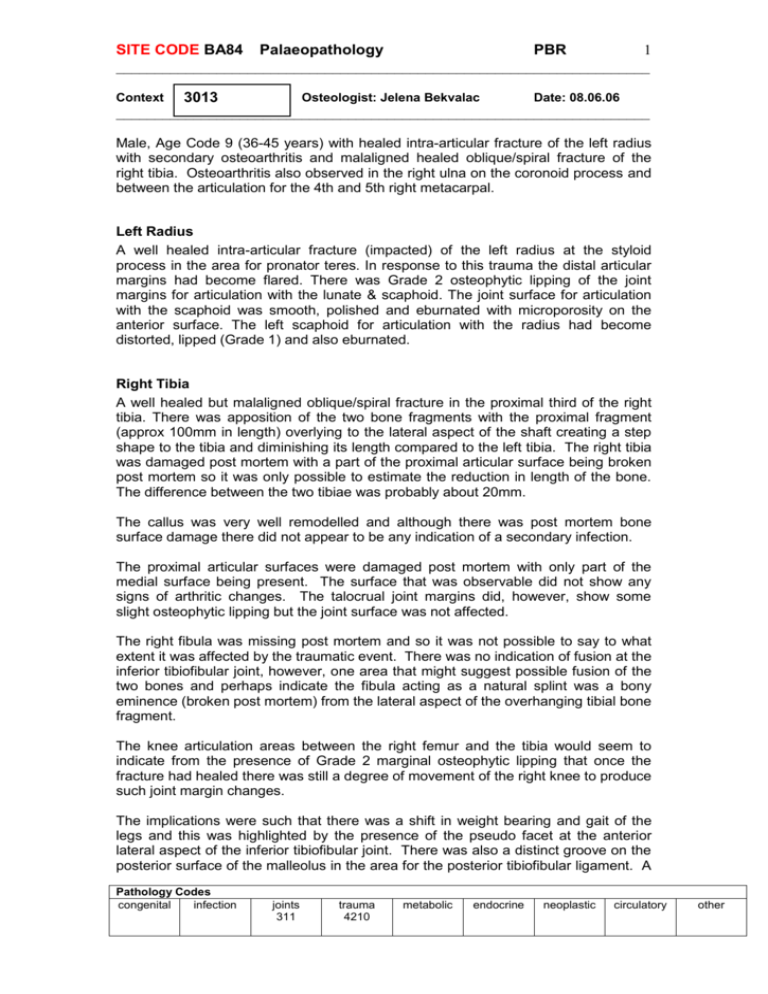
1 SITE CODE BA84 Palaeopathology PBR _____________________________________________________________________ Osteologist: Jelena Bekvalac Date: 08.06.06 3013 _____________________________________________________________________ Context Male, Age Code 9 (36-45 years) with healed intra-articular fracture of the left radius with secondary osteoarthritis and malaligned healed oblique/spiral fracture of the right tibia. Osteoarthritis also observed in the right ulna on the coronoid process and between the articulation for the 4th and 5th right metacarpal. Left Radius A well healed intra-articular fracture (impacted) of the left radius at the styloid process in the area for pronator teres. In response to this trauma the distal articular margins had become flared. There was Grade 2 osteophytic lipping of the joint margins for articulation with the lunate & scaphoid. The joint surface for articulation with the scaphoid was smooth, polished and eburnated with microporosity on the anterior surface. The left scaphoid for articulation with the radius had become distorted, lipped (Grade 1) and also eburnated. Right Tibia A well healed but malaligned oblique/spiral fracture in the proximal third of the right tibia. There was apposition of the two bone fragments with the proximal fragment (approx 100mm in length) overlying to the lateral aspect of the shaft creating a step shape to the tibia and diminishing its length compared to the left tibia. The right tibia was damaged post mortem with a part of the proximal articular surface being broken post mortem so it was only possible to estimate the reduction in length of the bone. The difference between the two tibiae was probably about 20mm. The callus was very well remodelled and although there was post mortem bone surface damage there did not appear to be any indication of a secondary infection. The proximal articular surfaces were damaged post mortem with only part of the medial surface being present. The surface that was observable did not show any signs of arthritic changes. The talocrual joint margins did, however, show some slight osteophytic lipping but the joint surface was not affected. The right fibula was missing post mortem and so it was not possible to say to what extent it was affected by the traumatic event. There was no indication of fusion at the inferior tibiofibular joint, however, one area that might suggest possible fusion of the two bones and perhaps indicate the fibula acting as a natural splint was a bony eminence (broken post mortem) from the lateral aspect of the overhanging tibial bone fragment. The knee articulation areas between the right femur and the tibia would seem to indicate from the presence of Grade 2 marginal osteophytic lipping that once the fracture had healed there was still a degree of movement of the right knee to produce such joint margin changes. The implications were such that there was a shift in weight bearing and gait of the legs and this was highlighted by the presence of the pseudo facet at the anterior lateral aspect of the inferior tibiofibular joint. There was also a distinct groove on the posterior surface of the malleolus in the area for the posterior tibiofibular ligament. A Pathology Codes congenital infection joints 311 trauma 4210 metabolic endocrine neoplastic circulatory other 2 SITE CODE BA84 Palaeopathology PBR _____________________________________________________________________ Osteologist: Jelena Bekvalac Date: 08.06.06 3013 _____________________________________________________________________ Context further indication perhaps of the added strain placed on the left leg from the imbalance caused by the trauma to the right tibia. Interestingly, neither of the hip joints appeared to be markedly affected with only Grade 1 ostephytic lipping being observed on the acetabular margins. The degree of healing evident in the fracture of the left radius with secondary osteoarthritis and the right tibia would seem to suggest that the traumatic event occurred quite a long time before death and that they may have been part of the same traumatic episode. Pathology Codes congenital infection joints 311 trauma 4210 metabolic endocrine neoplastic circulatory other
